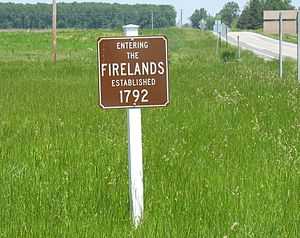The Firelands or Sufferers' Lands tract was located at the western end of the Connecticut Western Reserve in what is now the U.S. state of Ohio. It took the name "Fire Lands" because it was intended as restitution for residents of the Connecticut towns of Danbury, Fairfield, Greenwich, Groton, New Haven, New London, Norwalk, and Ridgefield. They had been burned out of their homes in 1779 and 1781 due to fires set by British forces during the American Revolutionary War. The area term is now spelled as one word, "Firelands".

Map of the Western Reserve in 1826: the Firelands are on the west end (left)
History
In 1792, for the Connecticut "Sufferers", the Connecticut legislature set aside 500,000 acres (2,000 km²), at the western end of the "Western Reserve", consisting of nearly all of the present-day counties of Huron and Erie counties, as well as Danbury Township (Marblehead Peninsula) and much of Catawba Island Township now in Ottawa County; and Ruggles Township now in Ashland County.
Few of the original "Sufferers" ever settled in the Firelands, because land speculators purchased almost all of the original claims, for re-sale. On April 15, 1803, the Sufferers, or their heirs, legal agents, and purchasers of their deeds, formed a corporation to manage the lands to which they were entitled in the newly formed state of Ohio.[1] The land was later divided into 30 five-mile (8 km) square survey townships, which were further subdivided into 120 quarters, each containing 4,000 acres (16 km2). (Note: Although the standard for U.S. survey townships in the Northwest Territory was six miles (approx. 10 km) square at that time, the older standard for survey townships in the Western Reserve was employed.) A drawing was held to determine the land received by each individual or household.
Some of the original townships in the Firelands were named for locations in Connecticut; and some were originally named for the land-speculators who had purchased them. (In some cases the pioneer settlers took a dislike to these speculators, and so changed their township names.) Later, after the War of 1812, when villages began to be established here, many of these villages were also named for Connecticut villages.
In 1811, Huron County encompassed the entire Firelands (and also included a portion of later Lorain County). Until 1837, all of the "Fire Lands" would lie within—and therefore co-exist with -- 'Huron County'.
Modern sign-posts erected within this area have the "established 1792" designation date, as mentioned above. The lands were physically surveyed from 1806-1808, and very slowly settled after 1808. No villages had developed within the 'Fire Lands' until about the end of the War of 1812.
Municipalities
Townships
Unincorporated places
| Ashland County |
| Hereford |
| Ruggles |
|
|
| Erie County |
|
| Anderson |
North Monroeville |
| Avery |
North Palm Beach |
| Axtel |
Oberlin Beach |
| Berlin Heights Station |
Ogontz |
| Berlinville |
Orchard Beach |
| Beulah Beach |
Parkertown |
| Birmingham |
Prout |
| Bloomingville |
Ranch Wood |
| Bluebird Beach |
Ruggles Beach |
| Bogart |
Rye Beach |
| Cedar Point |
Sand Hill |
| Ceylon |
Sandusky South |
| Chaska Beach |
Searsville |
| Columbus Park |
Shinrock |
| Crystal Rock |
Spears Corners |
| Fairview Lanes |
Springbrook |
| Florence |
Union Corners |
| Franklin Flats |
Venice |
| Heidelberg Beach |
Volunteer Bay |
| Joppa |
Weyers |
| Kimball |
Whites Landing |
| Mitiwanga |
Wilmer |
| North Milan |
|
|
| Huron County |
|
| Bismarck |
Huron Junction |
| Boughtonville |
Myers Mills |
| Celeryville |
New Haven |
| Centerton |
New Pittsburgh |
| Clarksfield |
North Monroeville |
| Collins |
Olena |
| Delphi |
Peru Hollow |
| East Norwalk |
Phoenix Mills |
| East Townsend |
Pontiac |
| Fitchville |
Standardsburg |
| Guinea Corners |
Steuben |
| Hanville Corners |
Strongs Ridge |
| Hartland |
Weavers Corners |
| Hartland Station |
West Clarksfield |
| Havana |
West Hartland |
| Holiday Lakes |
White Fox |
| Hunts Corners |
|
|
| Ottawa County |
| Danbury |
| Harbor Acres |
| Lakeside |
| Mineyahta-on-the-Bay |
|
|
Further reading
For further information see:
- Connecticut Archives, Revolutionary War, Series I, II, and III
- Connecticut Archives, Susquehanna Settlers and Western Lands, Series I and II
- Aldrich, Lewis C. History of Erie County Ohio. Evansville, IN: Unigraphic, 1978 [CSL call number: F497 .E5 H57 1978].
- Baughman, Abraham J. History of Huron County. Chicago: S. J. Clarke Pub. Co., 1909.
- Carpenter, Helen M. (1935). "The Origin and Location of the Firelands of the Western Reserve". Ohio Archaeological and Historical Quarterly XLIV: 162–203.
- The Firelands Pioneer / The Firelands Historical Society. 1858- [CSL call number F497 .W5 F5].
- Hill, George W. History of Ashland County, Ohio. Cleveland: Williams Bros., 1880.
- Williams, W.W., History of the Firelands, Connecticut, 1879.
(Publications with CSL call numbers are in the collection of the Connecticut State Library)
See also
References
External links
Coordinates: 41°15′N 82°30′W / 41.250°N 82.500°W / 41.250; -82.500


